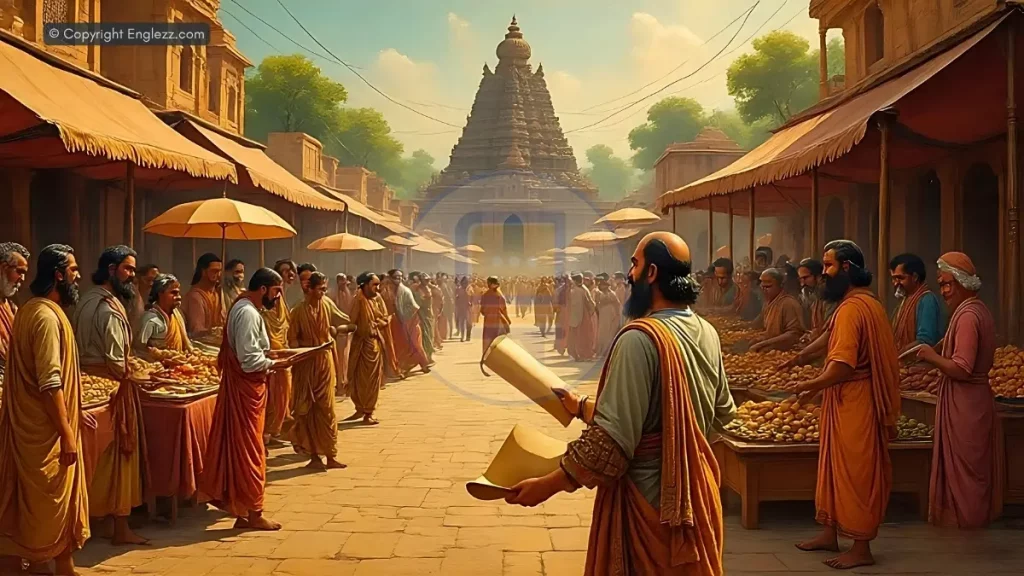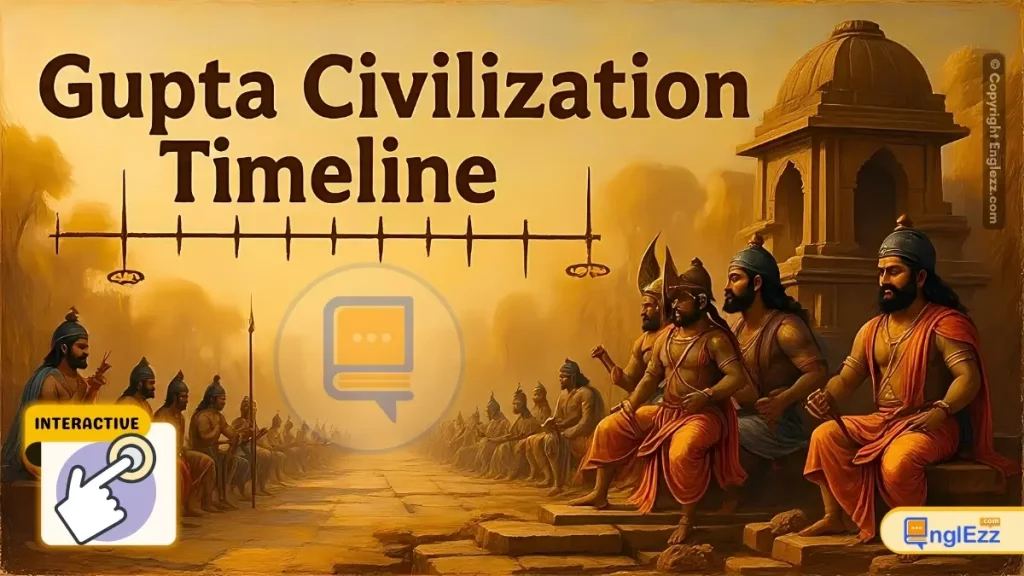
The Gupta Empire Civilization Timeline Map
India’s “Golden Age” (320-550 CE)
Introduction
India’s Golden Age
The Gupta Empire (320-550 CE) is considered the “Golden Age” of ancient India, marked by unprecedented achievements in arts, science, literature, and philosophy. Under Gupta rule, India experienced a cultural renaissance that would influence the subcontinent for centuries to come. The empire covered much of northern and central India, with its heartland in the fertile Ganges plain.
The Guptas excelled in administration, creating a stable political system that allowed culture to flourish. They were patrons of learning, supporting great universities like Nalanda. The period saw the compilation of classical Sanskrit literature, advancements in mathematics (including the concept of zero), and the creation of magnificent temples and sculptures that defined Hindu art.
Early Gupta Period
The Early Gupta period (320-400 CE) saw the foundation of the empire by Chandragupta I and its expansion under Samudragupta. During this time, the Gupta administrative system was established, and the empire began to assert control over northern India through both military conquest and diplomatic alliances.
Golden Age
The height of the Gupta Empire (400-500 CE) under Chandragupta II saw remarkable achievements in all fields of human endeavor. This was the era of Kalidasa’s poetry, Aryabhata’s astronomy, and the development of classical Indian art and architecture. The empire became a center of learning and culture that attracted scholars from across Asia.
Lasting Legacy
Though the Gupta Empire declined in the 6th century, its cultural and intellectual achievements continued to influence Indian civilization. The Gupta period established standards in art, literature, and science that became classical models. Today, historians recognize this era as foundational to India’s cultural identity.
Interactive Gupta Empire Timeline
Founding of the Gupta Empire
Chandragupta I establishes the Gupta Empire through marriage alliance and conquest, marking the beginning of India’s classical age.
Read moreChandragupta I (reigned c. 320-335 CE) founded the Gupta Empire by marrying Kumaradevi, a princess of the powerful Licchavi tribe. This strategic alliance gave him control over the rich agricultural lands of Magadha (modern Bihar) and access to the Ganges river trade routes.
Key aspects of Chandragupta I’s reign:
- Established Pataliputra (modern Patna) as the Gupta capital
- Introduced the Gupta era calendar system
- Laid the administrative foundations for the empire
- Issued gold coins depicting himself and his queen
Though his direct territorial control was limited to the Magadha region, Chandragupta I created the political and military framework that his successors would use to build a vast empire.
Further Reading
- Mookerji, Radhakumud. The Gupta Empire (1947)
- Sharma, R.S. India’s Ancient Past (2005)
Reign of Samudragupta
Samudragupta ascends to the throne and begins a series of military campaigns that expand Gupta power across India.
Read moreSamudragupta (reigned c. 335-375 CE), son of Chandragupta I, transformed the Gupta kingdom into a major empire through relentless military campaigns. His conquests are recorded in the Allahabad Pillar inscription composed by his court poet Harishena.
Samudragupta’s military achievements:
- Defeated nine kings of northern India, incorporating their territories
- Received tribute from twelve southern kings while allowing them to remain autonomous
- Subdued forest tribes and frontier kingdoms
- Received homage from foreign rulers including the Shakas and Kushans
Beyond his military prowess, Samudragupta was a patron of the arts and an accomplished musician, as depicted on his coins where he’s shown playing the veena. He performed the ancient Vedic horse sacrifice (Ashvamedha) to proclaim his imperial status.
Further Reading
- Allan, John. Coins of the Gupta Dynasties (1914)
- Majumdar, R.C. The Classical Accounts of India (1960)
Chandragupta II’s Reign Begins
Chandragupta II (Vikramaditya) ascends the throne, marking the beginning of the Gupta Golden Age.
Read moreChandragupta II (reigned c. 375-415 CE), son of Samudragupta, presided over the zenith of Gupta power and cultural achievement. His court at Ujjain became a center of learning that attracted scholars, artists, and philosophers from across Asia.
Key developments during his reign:
- Defeated the Western Shakas, gaining access to Arabian Sea trade
- Strengthened economic ties with the Roman Empire
- Patronized the “Nine Gems” of learning at his court, including the poet Kalidasa
- Issued silver coins that became a standard currency
- Commissioned the Iron Pillar of Delhi, a metallurgical marvel
Chinese traveler Faxian visited India during his reign, leaving valuable accounts of Gupta society. Chandragupta II took the title Vikramaditya (“Sun of Power”), which became synonymous with ideal kingship in Indian tradition.
Further Reading
- Thapar, Romila. Early India: From the Origins to AD 1300 (2002)
- Kulke, Hermann, and Dietmar Rothermund. A History of India (2004)
Flowering of Arts & Sciences
The Gupta period sees remarkable achievements in mathematics, astronomy, medicine, literature, and art.
Read moreThe 5th century CE represents the cultural apex of the Gupta Empire, with groundbreaking developments across multiple disciplines:
Mathematics & Astronomy:
- Aryabhata calculates π to four decimal places and proposes the heliocentric model
- Concept of zero as a number is developed
- Decimal system with place value notation emerges
Literature:
- Kalidasa writes his masterpieces including Shakuntala and Meghaduta
- Panchatantra fables are compiled
- Sanskrit becomes the language of elite culture
Art & Architecture:
- Development of the classical Gupta style in sculpture
- Construction of first free-standing Hindu temples
- Cave paintings at Ajanta reach their peak
Further Reading
- Basham, A.L. The Wonder That Was India (1954)
- Sen, S.N. Ancient Indian History and Civilization (1988)
Skandagupta’s Reign
Skandagupta ascends the throne and successfully repels Hun invasions, but the empire begins to weaken.
Read moreSkandagupta (reigned c. 455-467 CE) inherited an empire facing external threats and internal challenges. His most significant achievement was repelling the invading Hephthalite Huns (White Huns), though this defense strained imperial resources.
Key aspects of his reign:
- Victorious against the Huns in 455 CE, preserving Gupta sovereignty
- Issued the last great series of Gupta gold coins
- Maintained Gupta administrative systems but with reduced efficiency
- Faced economic difficulties due to military expenditures
Though Skandagupta temporarily stabilized the empire, his successors would struggle with recurring Hun invasions and provincial revolts. The quality of Gupta coinage declined during this period, reflecting economic troubles.
Further Reading
- Goyal, S.R. A History of the Imperial Guptas (1967)
- Puri, B.N. India Under the Kushanas (1965)
Decline of the Gupta Empire
The Gupta Empire fragments under pressure from Hun invasions and internal rebellions.
Read moreBy the early 6th century, the Gupta Empire had entered irreversible decline due to multiple factors:
External Pressures:
- Repeated Hun invasions under Toramana and Mihirakula
- Loss of western territories to Hun occupation
- Disruption of trade routes affecting the economy
Internal Challenges:
- Weak rulers unable to maintain central authority
- Rise of independent regional kingdoms
- Economic decline leading to reduced military capacity
- Administrative breakdown in provinces
The last recognized Gupta ruler, Vishnugupta, reigned around 540-550 CE, but by this time the empire had effectively dissolved into smaller kingdoms. The Hun invasions were eventually repelled by a coalition of Indian kings led by Yashodharman of Malwa in 528 CE.
Further Reading
- Smith, Vincent A. The Early History of India (1904)
- Raychaudhuri, H.C. Political History of Ancient India (1996)
Harsha’s Revival Attempt
King Harsha of Kannauj attempts to recreate Gupta-style imperial unity in northern India.
Read moreHarshavardhana (reigned 606-647 CE), commonly known as Harsha, sought to revive the glory of the Gupta Empire in the 7th century. Though not a Gupta himself, he modeled his administration and cultural patronage on Gupta precedents.
Key aspects of Harsha’s reign:
- Established control over much of northern India
- Patronized Buddhism while supporting Hindu traditions
- Held grand assemblies and cultural festivals
- Sponsored the university at Nalanda
- Chinese pilgrim Xuanzang left detailed accounts of his rule
Though Harsha’s empire collapsed after his death, his efforts demonstrated the enduring appeal of the Gupta model of kingship and cultural synthesis. The administrative systems he established influenced subsequent Indian kingdoms.
Further Reading
- Watters, Thomas. On Yuan Chwang’s Travels in India (1904)
- Devahuti, D. Harsha: A Political Study (1970)
Modern Rediscovery
Archaeologists and historians begin uncovering the achievements of the Gupta period.
Read moreThe Gupta Empire was rediscovered by modern scholars through several key developments:
Numismatic Evidence:
- Gupta gold coins found in various sites provided chronological evidence
- Coin legends helped reconstruct genealogy of Gupta kings
Archaeological Discoveries:
- Excavations at Nalanda revealed Gupta-era structures
- Temple remains at Deogarh and other sites documented
- Ajanta cave paintings studied and preserved
Epigraphic Records:
- Allahabad Pillar inscription deciphered
- Copper plate grants provided administrative details
These discoveries allowed historians to reconstruct the political history and appreciate the cultural achievements of what became known as India’s “Golden Age.” The Gupta period is now recognized as foundational to classical Indian civilization.
Further Reading
- Cunningham, Alexander. Archaeological Survey of India Reports (1871-1887)
- Singh, Upinder. A History of Ancient and Early Medieval India (2008)
Gupta Empire Quiz
Test Your Knowledge of India’s Golden Age
Frequently Asked Questions
Common Questions About the Gupta Empire Civilization
The Gupta period (c. 320-550 CE) is called India’s “Golden Age” because it witnessed unprecedented achievements in various fields:
- Political stability: The Gupta rulers established a vast, well-administered empire
- Cultural flourishing: Extraordinary developments in literature, art, and architecture
- Scientific advancement: Groundbreaking work in mathematics, astronomy, and medicine
- Religious harmony: Peaceful coexistence of Hinduism, Buddhism, and Jainism
- Economic prosperity: Thriving trade and urban centers
This period established classical standards in Indian arts and sciences that influenced subsequent centuries. The Gupta model of kingship and cultural synthesis became an ideal for later Indian rulers.
Gupta mathematicians made several groundbreaking contributions:
- Concept of zero: Developed zero as a number with its own value
- Decimal system: Created the base-10 place value system still used worldwide
- Algebra: Advanced techniques for solving equations
- Trigonometry: Developed sine tables and other trigonometric concepts
- Pi calculation: Aryabhata calculated π to four decimal places (3.1416)
- Astronomy: Proposed Earth’s rotation and correct explanations for eclipses
These mathematical concepts spread to the Arab world and eventually to Europe, forming the basis of modern mathematics.
The Gupta Empire had a sophisticated administrative system:
Central Administration:
- King as supreme ruler, assisted by ministers and advisors
- Council of ministers for specialized departments
- Well-organized bureaucracy with clear hierarchies
Provincial Administration:
- Empire divided into provinces (Bhuktis) under governors (Uparikas)
- Provinces further divided into districts (Vishayas)
- Village councils (Panchayats) for local governance
Key Features:
- Land grants to officials and religious institutions
- Efficient revenue collection system
- Maintenance of law and order
- Promotion of trade and commerce
The Gupta administration was decentralized yet effective, allowing local autonomy while maintaining imperial unity.
The Gupta Empire declined due to multiple interrelated factors:
External Factors:
- Invasions by the Hephthalite Huns (White Huns) in the 5th-6th centuries
- Pressure on northwestern frontiers draining military resources
Internal Factors:
- Weak successors after Skandagupta
- Rise of independent feudal lords and provincial governors
- Economic difficulties due to military expenditures
- Decline in trade affecting revenue
- Administrative decentralization leading to loss of control
Broader Changes:
- Shift in trade routes reducing economic importance of the Ganges valley
- Rise of regional powers challenging Gupta authority
- Changes in land tenure systems weakening central control
By the mid-6th century, the empire had fragmented into smaller kingdoms, though Gupta cultural influence persisted.
Conclusion
The Gupta Legacy
The Gupta Empire represents one of the most significant periods in Indian history, a time when political stability allowed for extraordinary cultural and intellectual achievements. From their origins as regional rulers to their establishment of a pan-Indian empire, the Guptas created an environment where arts, sciences, and philosophy could flourish.
Though the empire eventually declined, its cultural legacy endured. The classical standards established in Gupta-era literature, art, and science became reference points for subsequent Indian civilization. The period’s mathematical and astronomical discoveries would eventually influence the entire world.
Gupta Empire Civilization Key Takeaways
Early Foundations
The early Gupta period established the political and administrative framework for empire through strategic alliances and military conquests.
Golden Age
The Gupta Golden Age saw unparalleled achievements in all fields of learning and culture, setting classical standards for Indian civilization.
Late Period
Despite military and economic challenges, late Gupta rulers maintained cultural patronage even as political power decentralized.
Decline
Hun invasions and internal pressures led to the empire’s fragmentation, though regional Gupta dynasties continued to rule in some areas.
Enduring Legacy
Gupta achievements in mathematics, astronomy, literature, and art became foundational to Indian culture and influenced world civilization.
The study of the Gupta Empire reminds us of the heights human civilization can achieve when political stability, economic prosperity, and intellectual freedom converge. As we continue to uncover the depths of Gupta-era achievements, we gain not only historical knowledge but also inspiration from this remarkable chapter in human history.
Recommended Reading About the Gupta Empire
- Mookerji, Radhakumud. The Gupta Empire (1947)
- Basham, A.L. The Wonder That Was India (1954)
- Thapar, Romila. Early India: From the Origins to AD 1300 (2002)
- Singh, Upinder. A History of Ancient and Early Medieval India (2008)
- Sharma, R.S. India’s Ancient Past (2005)









